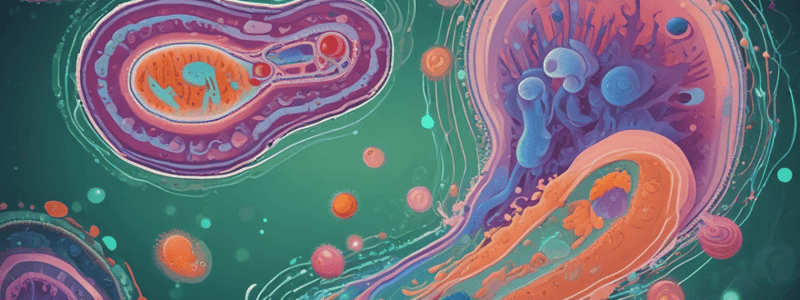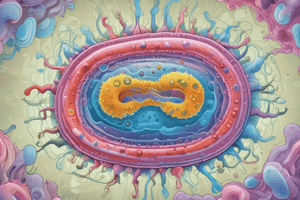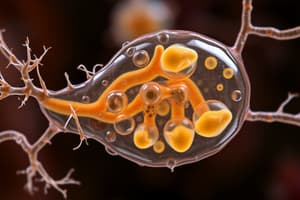Podcast
Questions and Answers
What is the characteristic of a prokaryote's chromosome?
What is the characteristic of a prokaryote's chromosome?
What is the function of plasmids in prokaryotes?
What is the function of plasmids in prokaryotes?
How do prokaryotes reproduce?
How do prokaryotes reproduce?
What is the result of rapid reproduction in prokaryotes?
What is the result of rapid reproduction in prokaryotes?
Signup and view all the answers
What is the process of combining DNA from two sources in prokaryotes?
What is the process of combining DNA from two sources in prokaryotes?
Signup and view all the answers
How do mutations contribute to genetic diversity in prokaryotes?
How do mutations contribute to genetic diversity in prokaryotes?
Signup and view all the answers
What is the advantage of prokaryotes' ability to produce a new generation rapidly?
What is the advantage of prokaryotes' ability to produce a new generation rapidly?
Signup and view all the answers
What is the function of the F factor in bacterial conjugation?
What is the function of the F factor in bacterial conjugation?
Signup and view all the answers
What is the result of an F+ cell transferring an entire F plasmid to an F– cell?
What is the result of an F+ cell transferring an entire F plasmid to an F– cell?
Signup and view all the answers
What is the term for cells that have the F factor integrated into their chromosome?
What is the term for cells that have the F factor integrated into their chromosome?
Signup and view all the answers
During conjugation, what structure temporarily forms between the donor and recipient cells?
During conjugation, what structure temporarily forms between the donor and recipient cells?
Signup and view all the answers
What is the result of an F+ cell transferring only part of the F plasmid to an F– cell?
What is the result of an F+ cell transferring only part of the F plasmid to an F– cell?
Signup and view all the answers
What is the role of the pilus in conjugation?
What is the role of the pilus in conjugation?
Signup and view all the answers
What is the primary function of decomposers in an ecosystem?
What is the primary function of decomposers in an ecosystem?
Signup and view all the answers
What type of prokaryotes convert atmospheric nitrogen into forms available to other organisms?
What type of prokaryotes convert atmospheric nitrogen into forms available to other organisms?
Signup and view all the answers
What is the term for the process by which homologous segments of chromosomal DNA are exchanged between cells?
What is the term for the process by which homologous segments of chromosomal DNA are exchanged between cells?
Signup and view all the answers
What is the term for an organism that harms its host but does not usually kill it?
What is the term for an organism that harms its host but does not usually kill it?
Signup and view all the answers
What is the estimated number of bacterial species present in the human intestines?
What is the estimated number of bacterial species present in the human intestines?
Signup and view all the answers
What is the term for an ecological relationship in which two species live in close contact, with one species being a larger host and the other being a smaller symbiont?
What is the term for an ecological relationship in which two species live in close contact, with one species being a larger host and the other being a smaller symbiont?
Signup and view all the answers
What is the primary benefit of autotrophic prokaryotes to other organisms?
What is the primary benefit of autotrophic prokaryotes to other organisms?
Signup and view all the answers
What is the term for an organism that benefits from another organism without harming or helping it?
What is the term for an organism that benefits from another organism without harming or helping it?
Signup and view all the answers
What is one way that mutualist intestinal bacteria benefit humans?
What is one way that mutualist intestinal bacteria benefit humans?
Signup and view all the answers
Which of the following foods is NOT produced with the help of bacteria?
Which of the following foods is NOT produced with the help of bacteria?
Signup and view all the answers
What is bioremediation?
What is bioremediation?
Signup and view all the answers
What proportion of human diseases are caused by bacteria?
What proportion of human diseases are caused by bacteria?
Signup and view all the answers
What is one way that bacteria can be used to produce energy?
What is one way that bacteria can be used to produce energy?
Signup and view all the answers
What is a benefit of having mutualist intestinal bacteria?
What is a benefit of having mutualist intestinal bacteria?
Signup and view all the answers
What type of organisms are all known pathogenic prokaryotes?
What type of organisms are all known pathogenic prokaryotes?
Signup and view all the answers
What is the primary mode of transmission of Lyme disease?
What is the primary mode of transmission of Lyme disease?
Signup and view all the answers
What is the main difference between exotoxins and endotoxins?
What is the main difference between exotoxins and endotoxins?
Signup and view all the answers
What is the consequence of horizontal gene transfer in E. coli?
What is the consequence of horizontal gene transfer in E. coli?
Signup and view all the answers
What is the approximate number of people infected with Lyme disease per year in the United States?
What is the approximate number of people infected with Lyme disease per year in the United States?
Signup and view all the answers
What is the main difference between pathogens and non-pathogens?
What is the main difference between pathogens and non-pathogens?
Signup and view all the answers
What is the result of the transfer of genes from pathogenic species to E. coli?
What is the result of the transfer of genes from pathogenic species to E. coli?
Signup and view all the answers
What is the result of the release of endotoxins?
What is the result of the release of endotoxins?
Signup and view all the answers
How many cases of E. coli infection are reported per year in the United States?
How many cases of E. coli infection are reported per year in the United States?
Signup and view all the answers




